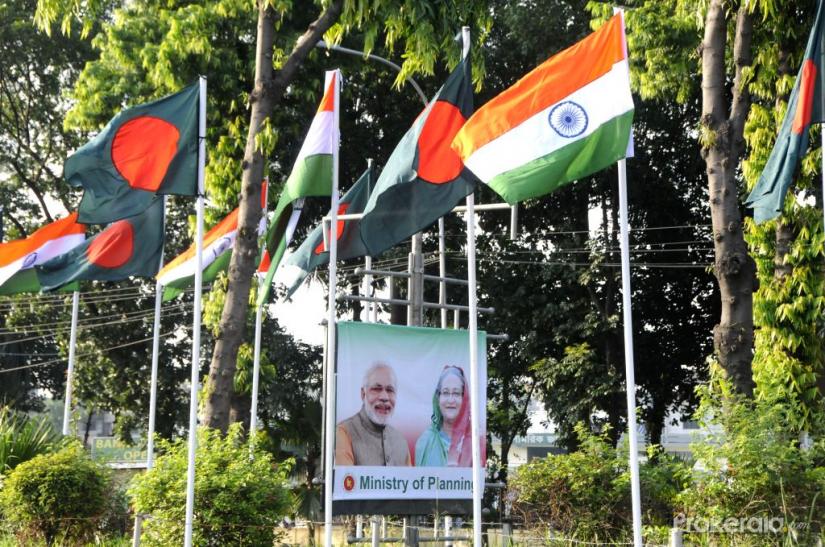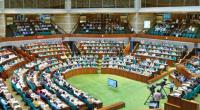 Despite maintaining that its relation with Dhaka is at an all-time best, Delhi is wary of Bangladesh economy, especially the prospect of Chinese investment in big-ticket projects.
Despite maintaining that its relation with Dhaka is at an all-time best, Delhi is wary of Bangladesh economy, especially the prospect of Chinese investment in big-ticket projects.
India has watched with growing unease in recent years as China has committed billions of dollars’ worth of funding to countries across the sub-continent to fulfil President Xi Jinping’s plans to build a new global trade route.
The Chinese president’s 2016 Bangladesh visit was marked by over US$20 billion in loan agreements indicating growing ties between Beijing and Dhaka.
Bangladesh Prime Minister Sheikh Hasina, however, has been maintaining a balance with the two big neighbours until now.
For instance, Dhaka’s keen interest in the Bangladesh-China-India-Myanmar Forum for Regional Cooperation (BCIM) economic corridor has rung alarm bells in Delhi.
China now maintains that the BCIM is a part of its Belt and Road Initiative (BRI).
India, however, is reluctant to attach itself to BRI. Part of this hesitance is rooted in concerns about Chinese intentions and the possibility of misusing the BRI as geostrategic leverage against India.
India has also refused to be part of the BRI plan due to the involvement of China in Pakistan, particularly in the China-Pakistan Economic Corridor (CPEC) which transgresses Indian-claimed but Pakistan-occupied Kashmir.
Delhi’s clear message on BCIM to Dhaka is — it will be only on board if it has no links with China’s BRI.
Former diplomat Rajeet Mitter, who served as the envoy to Dhaka, leads the Indian side in the BCIM economic corridor.
Speaking to Bangla Tribune, he said, “The Belt Road Initiative was floated just two or three years ago while negotiations over the BCIM corridors have been going on for 20 years. We think there’s no option to consider these matters as a single issue.”
FREE TRADE AGREEMENT
Another pressing concern for New Delhi is the free trade agreement (FTA), an issue raised by Indian Commerce Minister Suresh Prabhu during his Dhaka visit in September last year.
“As soon as Bangladesh graduates itself from least developed nations, it will lose the duty-free and quota-free access to Indian market,” a senior Indian commerce ministry official told Bangla Tribune.
“The existing trade pact within SAARC member states (SAFTA) will not be enough for Bangladesh to enter freely into the Indian market and that’s why we are focusing on a bilateral deal like an FTA,” the official said asking not to be named.
Two-way trade between the countries stood at $9.3 billion in the last FY2018, up by $1.8 billion from the previous fiscal.
Apart from India, Bangladesh has been in talks with several other countries including Sri Lanka, China and Pakistan over FTAs.
Negotiations have significantly progressed with Sri Lanka and China, but not at all with India or Pakistan.
ECONOMIC ZONE FOR INDIAN INVESTMENT
In its bid to attract foreign direct investments (FDI), Bangladesh has said that it will set up three special economic zones for Indian investors.
India is keen to combine with Bangladesh to build a South Asian manufacturing supply chain that uses their Bay of Bengal ports, the cheap labour and raw materials to manufacture garments, electronic goods and information technology services for export, according to media reports.
The proposed sites of the economic zones — Kushtia’s Bherhamara, Mirsharai Chattogram (Chittagong) and Mongla — have failed to woo Indian investors.
A top official of the top trade body, Federation of Indian Chambers of Commerce and Industry (FICCI), told Bangla Tribune, “We have told the Indian government at least one and half year ago that investors are interested in sites near Dhaka or Chattogram, like the ones for China and South Korea.”
THE TOLL OF ROHINGYA CRISIS ON THE ECONOMY
With a GDP per capita of $1,400, the Bangladeshi economy grew by 7.1 percent in 2016with remarkable progress toward the Millennium Development Goals (MDGs).
The Rohingya crisis, however, is straining Bangladesh, which has absorbed a huge number of people. According to international agencies, nearly 800,000 Rohingyas fled Myanmar since late 2017. Bangladesh is now home to nearly 1.1 million Rohingyas.
“It will hamper the progress and achievements in SDGs and MDGs,” says international NGO ‘The Asia Foundation’ country director Sarah Taylor.
The Rohingya crisis is gradually casting a shadow on Bangladesh’s remarkable progress in education, healthcare, socio-economic indicators over the last decade, according to her.
“Bangladesh has graduated to a lower mid-income state from a least developed country, but the next step can be tedious due to the refugee crisis,” she said.
While extensive international humanitarian relief has poured in to support the refugees, that doesn’t cover all the economic costs to the government or to the border region’s Bangladeshi citizens. The influx’s full effect may not be apparent for some time.
The coastal town and beaches of Cox’s Bazar used to be Bangladesh’s main tourist destination; now the area is awash with foreign aid workers. The area’s hoteliers are prospering, and many Bangladeshis have found jobs with humanitarian organizations. But day laborers and poorer locals have complained about price hikes for basic goods and about losing work to refugees willing to accept far lower wages.
 National
National
41336 hour(s) 11 minute(s) ago ;
Morning 03:06 ; Saturday ; Jul 05, 2025
Why India cautiously watches Bangladesh’s economy
Send
Ranjan Basu, Delhi
Published : 23:57, Feb 03, 2019 | Updated : 00:04, Feb 04, 2019
Published : 23:57, Feb 03, 2019 | Updated : 00:04, Feb 04, 2019
0 ...0 ...
/zmi/
Topics: Top Stories
- KOICA donates medical supplies to BSMMU
- 5 more flights to take back British nationals to London
- Covid19: Rajarbagh, Mohammadpur worst affected
- Momen joins UN solidarity song over COVID-19 combat
- Covid-19: OIC to hold special meeting
- WFP begins food distribution in Cox’s Bazar
- WFP begins food distribution in Cox’s Bazar
- 290 return home to Australia
- Third charter flight for US citizens to return home
- Dhaka proposes to postpone D8 Summit
Unauthorized use of news, image, information, etc published by Bangla Tribune is punishable by copyright law. Appropriate legal steps will be taken by the management against any person or body that infringes those laws.
Bangla Tribune is one of the most revered online newspapers in Bangladesh, due to its reputation of neutral coverage and incisive analysis.
F R Tower, 8/C Panthapath, Shukrabad, Dhaka-1207 | Phone: 58151324; 58151326, Fax: 58151329 | Mob: 01730794527, 01730794528


